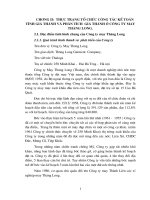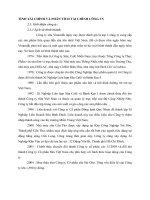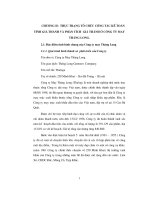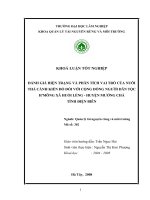Tính hiệu quả và phân tích hiệu quả của Nghiên cứu học thuật
Bạn đang xem bản rút gọn của tài liệu. Xem và tải ngay bản đầy đủ của tài liệu tại đây (316.37 KB, 15 trang )
CEPR Working Paper
WP-03/2008
Efficiency and Value Efficiency Analysis for Academic Research
Dao Nguyen Thang
Centre for Economic and Policy Research
College of Economics, Vietnam National University, Ha Noi
CENTRE FOR ECONOMIC AND POLICY RESEARCH
COLLEGE OF ECONOMICS, VIETNAM NATIONAL UNIVERSITY HANOI
CEPR
CENTRE FOR ECONOMIC AND POLICY RESEARCH
© 2008 Centre for Economic and Policy Research
College of Economics, Vietnam National University Hanoi
WP-03/2008
CEPR Working Paper
Efficiency and Value Efficiency Analysis for Academic Research
Dao Nguyen Thang
*
Email:
Abstract
This paper aims to propose a systematic approach to evaluate the efficiency of academic
research for Vietnam. Six criteria for measuring the performance of a research project are
proposed to quantify its quality. The data of two sorts of research - fundamental and
implemental - are employed to run the DEA BCC and BCC value efficiency models which are
considered as numerical examples to illustrate how to approach the work.
Keywords: Data envelopment analysis, Value efficiency, Academic research, Efficiency
score.
JEL Classification Numbers: C14, C44
This working paper should not be reported as representing the views of the CEPR. The views
expressed in this working paper are those of the author(s) and do not necessarily represent
those of the CEPR.
*
The author wishes to thank Prof. Pekka Korhonen (Helsinki School of Economics) for his kind supports on
useful materials. The author is grateful to scientists for constructive comments on the international conference
held at National Economics University in August 9
th
2007. All shortcomings or errors are of the author.
1. Introduction
Since the innovation of Charnes et al. (1978), studies in Data Envelopment Analysis (DEA)
have been extensively employed in measuring the efficiency of Decision Making Units in
many activities. Many fields of production, banking, insurance, etc. have been evaluated the
efficiency from micro to macro levels by employing DEA models developed by many
theorists. In Vietnam, these methodologies of DEA have been mainly employed by Nguyen
Khac Minh et al from 2002 to far.
Even though the methodologies of DEA have been applied in many fields of practical
activities, its applications on evaluating the efficiency of education and scientific research are
very limited. To our best knowledge, only Korhonen et al (2001) proposed the so-called value
efficiency model, which is basically based on DEA BCC model, to perform an efficiency
evaluation for 18 research units at the Helsinki school of economics. Inheriting this idea and
with the kind support of professor Korhonen, we conducted a research on value efficiency of
academic research for Vietnam which is considered the first step for a further more
comprehensive research in this field. Our research focuses on evaluating the efficiency of
some academic research of Ministry of Education and Training and of some institutes.
This paper consists of five sections including introduction. In section 2, we present the way to
develop the database for the performance analysis. Section 3 briefly reviews the traditional
DEA and value efficiency analysis. Section 4 presents the research performance analysis for
academic research. Section 5 gives some conclusion remarks.
2. Database and Indicators
In order to evaluate the performance of academic research, we address a set of evaluation
criteria as outputs which cover these contents below:
• Quality of academic research;
• Research activity;
• Impact of academic research;
• Activities in educating young scientists;
• Activities in Scientific Community;
• Application of the research in practice.
Four of these six criteria are referenced from the research of Korhonen et al. (2001) which are
rather close to the criteria applied in the quality assessment of academic research in the
Netherlands. All evaluation criteria are multi-dimensional because it is extremely difficult to
use a single dimension criterion to cover one aspect of a research project. These six criteria
are derived from 19 sub-criteria. So, it requires finding a way to combine the sub-criteria into
one criterion. The numerical information of all sub-criteria is derived from assessments of 41
experts who are professors and associate professors of many fields in disciplinary sciences.
The data for analysis are collected in two stages. Firstly, leaders of academic research are
directly interviewed to get detail and necessary information of the research in respect to
evaluation criteria above. Secondly, we conduct a survey to get ideas from experts for each
sub-criterion. From the ideas of experts, we construct a set of weight for each sub-criterion of
each kind research in respect to input. This is a necessary step to combine the sub-criteria into
one criterion.
Each of the criteria are based on combined information
a. Quality of academic research (Criterion 1)
o Number of articles relating to the research published in the domestic and
international journal by the research members.
o Number of books and chapters relating to the research edited by the research
member are published domestically and internationally.
o Number of citations from the published reports and material of the research
members.
b. Research activity (Criterion 2)
o Number of publications relating to the research are published in the non- refereed
books or journal
o Papers in conference proceedings, national reports, reports in the non-refereed
journal, working paper and other unpublished reports
o Number of reports of relating to the research are invited to present at National and
International Conferences
c. Impact of research (Criterion 3)
o Number of citations by other researchers (in journal articles, books, published
conference proceedings, and PhD dissertations)
o Number of foreign co-authors in journal articles
o Number of scientific research contract relating to the research sponsored from
organization after publishing the results of the research
o Number of training courses designed relating to the methodology of the research
d. Activity in Educating Young Scientists (Criterion 4)
o Number of Doctoral degrees and Master degrees produced
o Number of Doctoral students supervised
e. Activities in Scientific Community (Criterion 5)
o Memberships in editorial boards
o Number of research members are invited as experts for National Programmes and
International Programmes
o Number of research members are invited to represent at scientific conferences or to
be visiting professor for issues studied
o Number of research members are invited in National scientific organization and
International organization as experts in research field
f. Application of the research in practice (Criterion 6)
o Number of organizations have applied the results of the research
o Number of results of the research have been being granted in terms of pattern,
sample product, etc.
o The results of the research are background for establishing business unit
3. The methodology
3.1. Data Envelopment Analysis
Data Envelopment Analysis (DEA) developed by Charnes, Cooper and Rhodes (1978) has
become one of the most widely used methods in evaluating the relative efficiency of Decision
Making Units (DMUs). Assuming there are n DMUs each consuming m inputs and producing
p outputs. Let
m n
X
×
+
∈ℜ
and
p n
Y
×
+
∈ℜ
be the matrices, consisting of nonnegative elements,
including the observed inputs and outputs of DMUs. Let denote x
j
(the
j
th column of X) be the
vector of inputs consumed by DMU
j
, and
x
ij
be the quantity of input
I
consumed by DMU
j
. A
similar notation is used for outputs. Furthermore, let denote 1 = [
1,…,1
]
T
.
In this paper, the so-called BCC models with variable returns to scale proposed by Banker,
Charnes and Cooper (1984) are used to examine the relative efficiency among DMUs. In
output oriented BCC models, the efficiency of a DMU is determined by maximizing outputs
subject to given input levels. These models are presented in (3.1a) and (3.1b).
Output-Oriented BCC Primal
(BCC
P
– O)
Output-Oriented BCC Dual
(BCC
D
– O)
0
0
(1 1 )
. .
0,
,
1 1,
, , , 0,
0 ( )
T T
o
T
Max Z s s
s t
Y y s
X s x
z
s s z
Non Archimedian
θ ε
λ θ
λ
λ
λ
ε
+ −
+
−
− +
= + +
− − =
+ =
+ =
≥
> −
(3.1a)
0 0
0
. .
1,
1 0 ,
, 1,
0.
T
T
T T T T
Min W v x u
s t
y
Y v X u
v
µ
µ
µ ε
ε
= +
=
− + + ≥
≥
>
(3.1b)
A DMU is efficient iff
θ
*
= 1 and all slack variables s
-
, s
+
equal to zero, otherwise it is called
inefficient (Charnes et al., 1994).
3.2. Value Efficiency Analysis
Halme et al. (1999) proposed the idea of Value Efficiency Analysis. This is contrast with
traditional DEA which measure efficiency level of a DMU basing on its distance to the
efficiency frontier. Theoretically, the DM is assumed to have a (unknown) pseudo-concave
value function v(u),
n p
y
u
x
+
= ∈ℜ
−
, which is strictly increasing (meaning strictly increasing in
y
and strictly decreasing in
x)
and with a (local) maximal value v(u
*
),
*
*
*
y
u T
x
= ∈
−
(where T
is the feasible set), at the Most Preferred Solution (see Korhonen et al., 2001).
Value efficiency analysis allows evaluating efficiency of each DMU in relation to the
indifference contour of that (unknown) value function crossing through the Most Prefererred
Solution. However, generally it is not realistic to assume that the value function is known or









